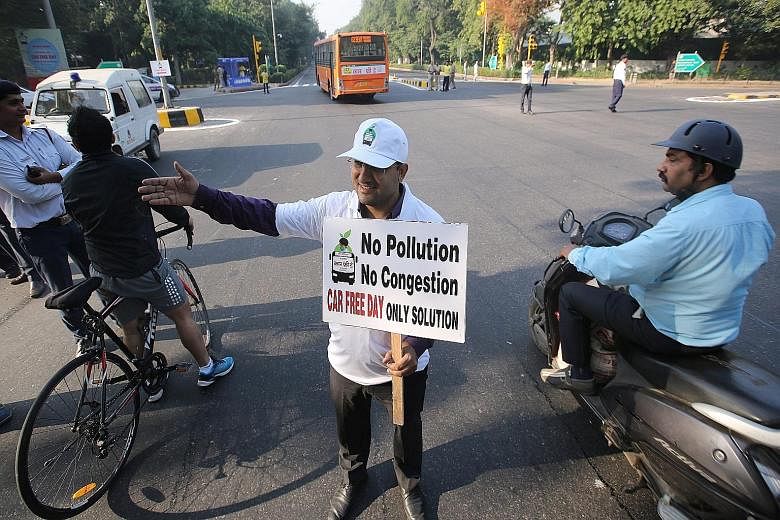As winter approaches each year, the threat of bad air hangs heavily over Delhi, one of the world's most polluted capital cities. Smog and soot often force people with respiratory problems to stay indoors.
But this year, some new initiatives are raising hope that the skies can be made a little clearer.
Delhi and its satellite city Gurgaon are experimenting with car-free days to push people into using public transport. In addition, truckers will have to pay an environment tax ranging from 700 rupees to 1,300 rupees (S$15 to S$28) per entry, to discourage them from driving through the capital.
On Thursday,6km of a busy road, from India Gate to old Delhi, was closed to private vehicles for five hours, bringing pollution levels down by 60 per cent along the stretch, according to the Centre for Science and Environment (CSE).
"Thursday points to what is possible. That stretch was free of cars and traffic, and showed a decline in pollution," said CSE executive director Anumita Roychowdhury. "If the total traffic volume in the city comes down, we will see a dramatic improvement in air quality."
According to the CSE, PM2.5 - an air pollutant smaller than 2.5 micrometres - was at 265 micrograms per cubic metre on Thursday, compared to other days, when it is 689. The World Health Organisation's maximum average annual exposure level is 10.
With 17 million people, Delhi's public transport is crowded and its vehicle growth unchecked, with motorists preferring diesel cars because of lower fuel costs. Industries coming up in satellite cities and wood fires burning in nearby rural areas have also contributed to soaring pollution levels.
The city adds 1,400 new cars daily to the existing 8.5 million vehicles, while 52,000 commercial vehicles enter each day. Trucks contribute to 30 per cent of air pollution while private vehicles pour in more than 60 per cent.
The WHO said in May this year that Delhi, with an average PM2.5 level of 153 micrograms per cubic metre, had the dirtiest air among 1,600 cities, beating Beijing, which had a PM2.5 level of 56.
Many hailed the car-free day effort as a first step. The government plans to repeat the exercise on the 22nd of every month.
Indian diplomat Devyani Khobragade was among Delhi residents who decided not to drive on Thursday and cycled instead.
"I can see and smell the pollution and feel it on the road," she said. "I was happy with this initiative."
The Delhi government has warned that it is coming up with tough measures to stop people from driving, but faces criticism for not spelling out the measures.
Experts said much more is needed to stop people from taking out their cars every day, like hiking parking charges from a paltry 10 rupees to 20 rupees.
"One car-free day every month reduces it to a symbolic gesture. Last winter was very bad in terms of pollution," said Ms Roychowdhury. "We haven't seen any major steps taken by the government. Right now, to deal with pollution levels in Delhi, there is no one silver bullet. They really have to take different pieces of action, then aggregated impact will show up. That is not happening. "
But Delhi transport official Anil Chikkara said residents of Delhi must do much more. "Pollution is a social problem; 90 per cent activity can be taken care of by the public," he said. "Only 10 per cent by government. Only then we can negate pollution."

